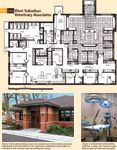A high-tech practice prairie style
After 50 years in one location, West Suburban Veterinary Associates is poised for 50 more years of success in a new facility with a meticulous floor plan and cutting-edge technology.
A NEW FACILITY IS AN OPPORTUNITY FOR MORE than just a new structure. For example, Dr. Alan Main, owner of West Suburban Veterinary Associates in Westmont, Ill., took advantage of the chance to integrate new technology into the new building—and plan for ultra-efficient workflow. His team collaborated to create a warm and inviting environment for clients. And sixteen months into working in the new practice, less than two blocks from the old building, everyone is happy with the result.

Reception: A large desk accommodates three receptionists and a handicap-accessible transaction area. Clients can wait in one of two separate bench-seating areas and help themselves to coffee from a refreshment stand. Half walls at the end of the benches provide privacy. Stained-glass skylights and a coffered ceiling reflect the prairie-style architecture.
The high-tech yet traditional prairie-style facility impressed the 2006 Veterinary Economics Hospital Design Competition judges who named the new facility a Merit Award winner. But the judges weren't the only ones to recognize West Suburban Veterinary Clinic. The village of Westmont recognized the new practice with a community improvement award, too.
Crafting a perfect floor plan
Brainstorming about traffic flow, safety, and work efficiency led to a rectangular floor plan instead of a typical linear plan. The result is two parallel corridors that run the length of the building, with numerous connections between them.
"The floor plan has been terrific to work in," says Dr. Main. There aren't any dead-end hallways. "And the rear corridor allows doctors and team members to move laterally through the work areas, reducing congestion and making it possible to bring clients to exam rooms without passing through the treatment area," he says.

Floor plan: West Suburban Veterinary Associates
Dr. Main and his team also incorporated a few unique features that improve efficiency, comfort, and accuracy. For instance, they designed a solid-surface worktable with grooves rather than a grate for drainage that's more comfortable for animals to stand on. They also included a four-tank oxygen delivery system with an alarm; a central gas scavenger with drop sites for anesthesia machines all over the hospital; a central vacuum system; and central medical suction, with the noisy generator in an upstairs room.
One of Dr. Main's favorite features: the communication hubs. "We tend to gather in certain areas of the hospital to discuss cases, so I built in space to accommodate these talks," he says. The radiography suite, library, and the pharmacy all include a workstation and extra space for the doctors to congregate, review radiographs, and discuss cases—without the need to go in an office.
Going high tech
"I was captivated by digital radiography and determined to incorporate this technology as a hallmark feature of the new hospital," says Dr. Main. Knowing that the new hospital would require a substantial computer network, he worked to minimize duplication of hardware and integrate the digital radiography with the hospital information system. "Little did I know, I was on the frontier of this technology," he says.
During an out-of-state ultrasound system training session, Dr. Main met with a digital radiography company that shared his interest in technology integration. They worked with the practice-management software company to integrate the systems. Three months before the hospital opened, he and his team members began training on the new computer system, so it wasn't such a shock when they moved into the new facility.
While adding technology isn't strictly an architectural issue, Dr. Main says his goal to build a seamless, integrated network helped focus his design. "From putting computer screens in every exam room with computer arms to mount them, to installing hidden data ports and computer wires, we thought through every detail and then refined the design to accommodate our new technology," he says.
For example, all digital radiographs, ultrasounds, photos, and slides from the digital microscope are immediately incorporated into a patient's records. Dr. Main and his team members can call up the same picture or file from anywhere in the hospital at the same time.

A look at the numbers
"The best part is, I can sit in my office or an exam room, talking with a colleague or a client, and bring up the ultrasound, radiograph, and pictures one after another without taking a single step," he says. "That is very exciting for our staff as well as our clients."
Enjoying a labor of love
"Constructing a new hospital is a labor of love," says Dr. Main. "It's a once in a lifetime opportunity to offer patients cutting-edge veterinary medicine and surgery, to provide a terrific work environment for our staff members, and to add a beautiful building to the city's landscape."
He and his team are enjoying the comfort and functionality of their new digs. "As with any project of this magnitude, there were many challenges," says Dr. Main. But he says it was the team of people who worked tirelessly that made the process a lasting and happy memory. "Many of the employees, and several of our spouses, worked all through the weekend of the big move," says Dr. Main.
A learning experience
"Going through a building experience brings out talents that you didn't know you had," he says. "And you'll meet people you wouldn't have met otherwise. You need to be resourceful and resilient."

Know what you want going in
In the end, you'll have a great personal accomplishment as well as a contribution to veterinary medicine. A beautiful new hospital can make you see the practice of veterinary medicine in a whole new light."
Sarah A. Moser is a freelance writer and editor in Olathe, Kan. Please send questions or comments ve@advanstar.com.